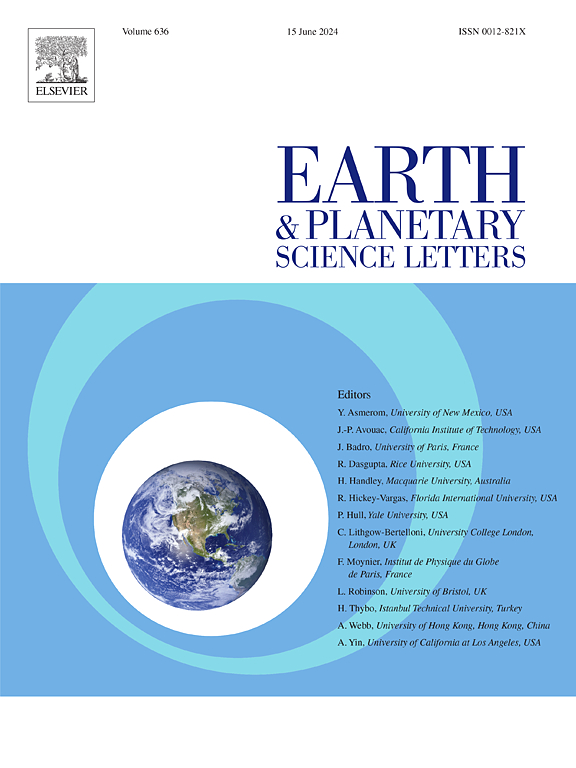Detection of a ULVZ in the Central Pacific using high frequency Sdiff postcursors
IF 4.8
1区 地球科学
Q1 GEOCHEMISTRY & GEOPHYSICS
引用次数: 0
Abstract
In recent decades, ultra-low velocity zones (ULVZs) – thin patches of strongly reduced seismic velocity atop the core-mantle boundary (CMB) – have been inferred from observations of a variety of seismic phases. One such phase is Sdiff and its out-of-plane postcursory energy, Sdiff+. In this study, we present a high quality dataset of Sdiff and Sdiff+ which shows evidence of a ULVZ in the central Pacific, roughly between Hawaii and Marquesas. The observed Sdiff+ have an unusually short dominant period (5–12 seconds) compared to previous Sdiff+ observations, which is indicative of a ULVZ that is approximately 10–15 km thick. We analyse this high frequency dataset using the 2D Wavefront Tracker (2DWT) Bayesian inversion methodology to generate a probabilistic ensemble of ULVZ models. As a result of the uniazimuthal coverage of data, there is a strong southwest-northeast trade-off, but there is a slight preference for the ULVZ to be located just outside the Pacific large low velocity province (LLVP) boundary, roughly centred 20° north of Marquesas and 20° southeast of Hawaii. The 2DWT inversion of Sdiff+ travel times suggest that the ULVZ can be approximated as a cylindrical structure; either as a larger and weaker anomaly (radius 280 km, dVs -20%) close to the LLVP, or a smaller and stronger anomaly (radius 180 km, dVs -30%) further away from the LLVP. Unlike previous broad-scale ULVZs modelled with Sdiff+, this ULVZ is thinner, might lie outside of an LLVP, and lacks a potential relationship to a mantle plume.
利用高频 Sdiff 后验器探测中太平洋的超低海流区
近几十年来,根据对各种地震相位的观测,推断出了超低速度区(ULVZs)--地核-地幔边界(CMB)上地震速度强烈减弱的薄片。其中一个相位是 Sdiff 及其平面外后发能量 Sdiff+。在这项研究中,我们展示了一个高质量的 Sdiff 和 Sdiff+ 数据集,该数据集显示了在太平洋中部(大致在夏威夷和马克萨斯群岛之间)存在超低变区的证据。与之前的 Sdiff+ 观测结果相比,观测到的 Sdiff+ 的主周期(5-12 秒)异常短,这表明超低频带的厚度约为 10-15 千米。我们利用二维波前跟踪器(2DWT)贝叶斯反演方法分析了这一高频数据集,生成了一个超低频谱区概率模型集合。由于数据的单方位角覆盖,西南-东北方向有很强的权衡,但超低压带略微偏向于位于太平洋大低速区(LLVP)边界之外,大致以马克萨斯群岛以北 20° 和夏威夷东南 20° 为中心。Sdiff+ 移动时间的 2DWT 反演表明,超低强度区可以近似为一个圆柱形结构;或者是靠近低纬度带的一个较大且较弱的异常(半径 280 千米,dVs -20%),或者是远离低纬度带的一个较小且较强的异常(半径 180 千米,dVs -30%)。与以前用 Sdiff+ 模拟的大尺度超低变异区不同,这个超低变异区更薄,可能位于 LLVP 之外,而且与地幔羽流缺乏潜在关系。
本文章由计算机程序翻译,如有差异,请以英文原文为准。
求助全文
约1分钟内获得全文
求助全文
来源期刊

Earth and Planetary Science Letters
地学-地球化学与地球物理
CiteScore
10.30
自引率
5.70%
发文量
475
审稿时长
2.8 months
期刊介绍:
Earth and Planetary Science Letters (EPSL) is a leading journal for researchers across the entire Earth and planetary sciences community. It publishes concise, exciting, high-impact articles ("Letters") of broad interest. Its focus is on physical and chemical processes, the evolution and general properties of the Earth and planets - from their deep interiors to their atmospheres. EPSL also includes a Frontiers section, featuring invited high-profile synthesis articles by leading experts on timely topics to bring cutting-edge research to the wider community.
 求助内容:
求助内容: 应助结果提醒方式:
应助结果提醒方式:


